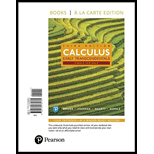
Concept explainers
Explain why or why not Determine whether the following statements are true and give an explanation or counterexample.
a. The differential equation y′ + 2y = t is first-order, linear, and separable.
b. The differential equation y′y = 2t2 is first-order, linear, and separable.
c. The function y = t + 1/t satisfies the initial value problem ty′ + y = 2t, y(1) = 2.
d. The direction field for the differential equation y′(t) = t + y(t) is plotted in the ty-plane.
e. Euler’s method gives the exact solution to the initial value problem y′ = ty2, y(0) = 3 on the interval [0, a] provided a is not too large.
a.
Whether the given statement is true or false.
Answer to Problem 1RE
The statement is False.
Explanation of Solution
The statement is the differential equation is first order, linear, and separable.
The given equation is
The order of this equation is one.
Thus, the equation is in first order.
The function y and its derivatives are in first order and not composed with other functions.
A linear equation cannot have products or quotients of y and its derivatives.
Thus, the equation is linear.
In the equation
But here the equation is not separable.
Therefore, the equation is in first order, linear but not separable.
Thus, the statement is false.
b.
Whether the given statement is true or false.
Answer to Problem 1RE
The statement is False.
Explanation of Solution
The given equation is
The order of this equation is one.
Thus, the equation is in first order.
Here, the function y and its derivatives are in first order and not composed with other functions.
A linear equation cannot have products or quotients of y and its derivatives.
Thus, the equation is not linear.
In the equation
But here the equation is separable.
Therefore, the equation is in first order, separable but not linear.
Thus, the statement is False.
c.
Whether the given statement is true or false.
Answer to Problem 1RE
The statement is true.
Explanation of Solution
The given differential equation is
The initial value problem is
Take derivative on both sides in
Substitute the value of
Therefore, the function
Thus, the statement is true.
d.
Whether the direction field for the differential equation
Answer to Problem 1RE
True, the direction field for the differential equation
Explanation of Solution
The differential equation is
The equation is in first order
So, the notation
The differential equation at each point
A direction field is a picture that shows the slope of the solution at
Therefore the direction field for the differential equation
e.
Whether the given statement is true or false.
Answer to Problem 1RE
The statement is false.
Explanation of Solution
The carry capacity either greater than or less than the value predicted by the model.
The given initial value problem is
Direction fields are the basis for many computer based methods for approximating solutions of a differential equation.
The exact solution of the initial value problem at grid points is
Which is generally unknown unless solve the original differential equation.
The goal is to compute a set of approximations to the exact solution at the grid points.
Therefore, the given assumption is false Euler method gives approximate solution not exact solution.
Thus, the statement is false.
Want to see more full solutions like this?
Chapter 9 Solutions
Single Variable Calculus Format: Unbound (saleable)
- 2. Find a matrix A with the following qualities a. A is 3 x 3. b. The matrix A is not lower triangular and is not upper triangular. c. At least one value in each row is not a 1, 2,-1, -2, or 0 d. A is invertible.arrow_forwardFind the exact area inside r=2sin(2\theta ) and outside r=\sqrt(3)arrow_forwardA 20 foot ladder rests on level ground; its head (top) is against a vertical wall. The bottom of the ladder begins by being 12 feet from the wall but begins moving away at the rate of 0.1 feet per second. At what rate is the top of the ladder slipping down the wall? You may use a calculator.arrow_forward
- Explain the key points and reasons for the establishment of 12.3.2(integral Test)arrow_forwardUse 12.4.2 to determine whether the infinite series on the right side of equation 12.6.5, 12.6.6 and 12.6.7 converges for every real number x.arrow_forwarduse Cauchy Mean-Value Theorem to derive Corollary 12.6.2, and then derive 12.6.3arrow_forward
 Linear Algebra: A Modern IntroductionAlgebraISBN:9781285463247Author:David PoolePublisher:Cengage Learning
Linear Algebra: A Modern IntroductionAlgebraISBN:9781285463247Author:David PoolePublisher:Cengage Learning
